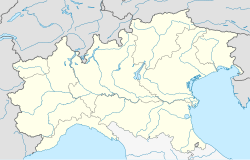You can help expand this article with text translated from the corresponding article in Italian. (September 2024)Click [show] for important translation instructions.
|
 | |||||||||||
| General information | |||||||||||
| Location | Piazza Cordusio, Milan | ||||||||||
| Coordinates | 45°27′56″N9°11′11″E / 45.46556°N 9.18639°E | ||||||||||
| Owned by | Azienda Trasporti Milanesi | ||||||||||
| Platforms | 2 | ||||||||||
| Tracks | 2 | ||||||||||
| Construction | |||||||||||
| Structure type | Underground | ||||||||||
| Accessible | Yes | ||||||||||
| Other information | |||||||||||
| Fare zone | STIBM: Mi1 [1] | ||||||||||
| History | |||||||||||
| Opened | 1 November 1964 | ||||||||||
| Services | |||||||||||
| |||||||||||
| |||||||||||
Cordusio is a station on Line 1 of the Milan Metro in the busy, commercial Piazzale Cordusio. It was opened on 1 November 1964 as part of the inaugural section of the Metro, between Sesto Marelli and Lotto. [2] The station is near the piazza del Duomo, and the long via Dante, which leads up to the Castello Sforzesco.
As with the square in which it is located, it takes its name from the Curia Ducis, the Court of Duke: this name dates back to the Longobard period.




